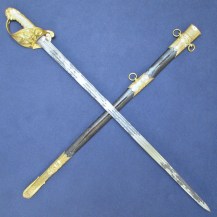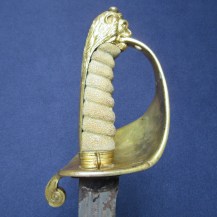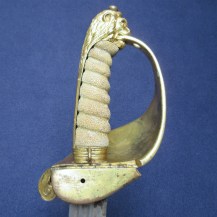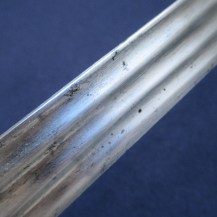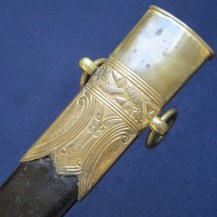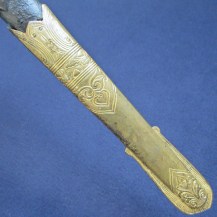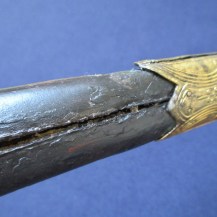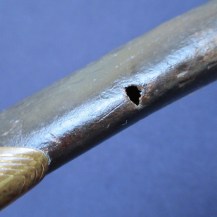British 1827 Pattern Naval Flag Officer’s Sword with ‘Andrea Ferrara’ Broadsword Blade
Triple-fullered broadsword blade 29 inches in length, 35 inches overall. Gilt brass half-basket hilt cast with a crown and fouled anchor within a cartouche, hinged inner guard, brass backstrap with lion head pommel cap, white shagreen grip, brass ferrule with sword knot ring. Black leather scabbard with gilt brass fittings at the throat, chape and middle, the throat with two opposed hanging rings and the middle piece with one hanging ring.
The blade is engraved on both sides with ‘ANDREA FARARA’ [sic], and also features the royal crown and coat of arms with motto ‘HONI SOIT QUI MAL Y PENSE’, a quatrefoil design, a sunburst at the ricasso and feathers (possibly the three feathers heraldrically associated with the Prince of Wales). The top piece of the scabbard is engraved with the maker’s mark ‘PROSSER Maker to the King and Royal Family LONDON’.
The level of decoration of the scabbard signifies that this was the sword of a flag officer – that is, an officer with a rank higher than Captain. It conforms to regulations laid down in 1832 for flag officer’s scabbards, with one modification – a third hanging ring was added later on the opposite side of the chape piece to the original. This was a change introduced in 1847, showing that this sword was still being carried by that date.
Higher-ranking naval officers could get away with significant variations in their uniform swords – some are even recorded as having carried foreign swords or British models that had been declared obsolete. This scabbard may have been produced at a later date than the sword, either after the 1832 regulations or upon the officer’s promotion to flag rank, since the ring fixed to the ferrule typically indicates an early example of the 1827 Pattern sword hilt.
The use of a broadsword blade in a British naval sword is not unheard of: the National Maritime Museum at Greenwich holds seven examples of such blades. However, these all date from 1870-1882 and result from the use of standard-pattern broadsword blades, which were produced for Scottish infantry regiments from 1866. With such blades readily available some officers may simply have chosen them for looks or personal preference.
This sword is an example of an earlier practice, one more often seen in the Army, of officers reusing broadsword blades of the 17th or early 18th century, fitting them into the regulation pattern hilt and accoutrements to make them fit for service in a new era – or fit enough not to stand out too much on parade, at least. It is quite likely that these were inherited ‘family’ blades, since it was a common practice (particularly in Scotland) to rehilt swords and keep them in use over generations. I have found no reference to this being done to produce a naval sword before, this example may be rare or unique in that respect.
For an excellent pair of examples, see The British Cavalry Sword (Companion Volume) by Richard Dellar, page 25, depicting the 1796 Pattern dress and undress swords of Lieutenant-Colonel David Home of the 2nd Dragoons. Both of Home’s swords have ‘Ferara’ [sic] marked broadsword blades, fitted by the London cutler Johnston into regulation hilts at some point between 1798 and 1802, with custom scabbards to match.
Andrea Ferrara is a name that appears quite often (with a number of spelling variations) on English and Scottish blades of the 17th century, leading to much speculation as to who this celebrated swordsmith was. Giovan Cigogna, describing Venetian swordsmiths in his book Trattato Militare (1583) writes that “in the town of Bellune are the ingenious master Giouan Donato and master Andrea dei Ferari, both brothers.” The town is today called Belluno, and a contract exists in the State Archives of Belluno from December 1578 in which these same brothers agree to supply 600 swords ‘of the kind used in England’ per month for ten years to a London-based importer, a huge quantity which suggests that their operation was at a significant scale for its time, although whether the contract was filled entirely or cancelled at some point is unknown.
There is no evidence that either brother ever visited Britain and despite the quantity mentioned in the contract no more than a fraction of the blades found today can possibly have been made in Belluno, especially as many are clearly more recent. Rather it would seem that the imported blades were of such impressive quality that the Ferrara mark was counterfeited by others and/or used as a general mark for a blade of superior quality rather than specific manufacture. The fact that ‘Andrew Ferrara’ or simply ‘Ferrara’ became a slang term for the Scottish broadsword and sometimes for swords in general supports this interpretation, and it is unlikely that many people at the time believed their blade was forged by the man himself.
John Prosser was a prominent London sword cutler who took over the business of his employer Thomas Cullum in 1795 and traded on Charing Cross Road until 1860, specializing in high-quality blades including custom officer’s swords and presentation swords. He was creative with his commissions and invented the ‘quill-point’ blade in 1818. In his early years of business he developed a close relationship with the Prince of Wales, whose infatuation with military pomp led him to commission several swords from Prosser, including a set awarded to the officers of the 10th Hussars, his pet cavalry regiment, in 1808. This connection was rewarded with titles: Prosser was appointed Sword Cutler and Beltmaker to King George III and in 1820 was made Sword Cutler in ordinary to King George IV (the former Prince). Prosser’s firm proudly displayed these royal connections on every sword sold, in this case a custom version of the naval officer’s hilt and scabbard to accommodate a pre-existing blade. It is possible that Prosser did not do the rehilting, since Prosser-made naval swords typically do not feature a folding guard, but this cannot be proven either way without a maker’s mark on the sword itself.
The blade has some areas of pitting and what look like repairs in places to fill in old damage. This has sadly obscured some of the engraving, which is unusually extensive for a Ferrara blade and might have been added to over time. The scabbard leather has shrunk and hardened with age, which has burst its stitching along the seam. Its fittings are all sound and retain a good deal of gilding, while the sword’s hilt retains almost all of its gilding even in areas that would be handled more. The hinged flap of the hilt works well and fits onto a pin at the scabbard’s throat to lock the sword into the scabbard. The shagreen grip was almost certainly originally bound with wire, but this has been lost. The white shagreen itself is in good condition, with no damage and little handling wear.


